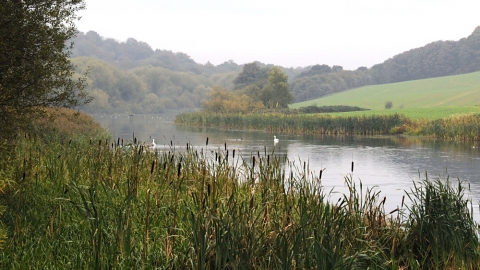
Sprotbrough Flash Nature Reserve
Location
Know before you go
Dogs
When to visit
Opening times
Open at all timesBest time to visit
March to September
About
Sprotborough Flash offers a mixed site with ancient woodland, a large lake and small area of grassland. The lake is home to birds of wetland and wet woodland like reed and sedge warblers, reed buntings and tufted ducks. The woods have patches of bluebells and violets.
The impressive diversity of wildlife found at Sprotbrough Flash results from the range of habitats which have developed on the unusual magnesian limestone bedrock. The nature reserve is located in the Don Gorge, where the River Don cuts through the elevated limestone ridge to the west of Doncaster.
The site protects fragments of ancient woodland on the slopes of the gorge, while wildlife-rich grassland can be found on the limestone plateau and a restored quarry site at the north end of the nature reserve.
The limestone woodland, protected within the nature reserve, is dominated by ash, wych elm and sycamore, with a varied shrub layer typical of this woodland type, with species such as hazel, spindle and guelder rose. There are some magnificent specimens of small-leaved lime and an avenue of mature yew, and the woodland immediately to the north west supports a nationally notable array of ancient woodland invertebrates. The wood is home to good populations of breeding woodland birds - all three species of woodpecker have been recorded here. In spring enjoy the woodland flowers like violets and bluebells
Small areas of limestone grassland occur on the plateau at the top of the wooded slopes, supporting a dizzying variety of specialist limestone wildflowers and insects. Over recent years the areas of this valuable habitat has been significantly increased through scrub removal and its condition has been enhanced by the introduction of conservation grazing, using traditional breeds of sheep.
Botanical highlights include good displays of cowslip, common spotted and pyramidal orchids, with common twayblade, bee orchid, carline thistle, quaking grass and autumn gentian among many others.
Brown hares can be seen on the grassland and dashing across the adjacent arable fields, while grass snakes are also a common sight basking on the grassland in the morning sun.
Amongst the bird highlights to enjoy are great crested grebes displaying in spring; birds around the flash during summer months include blackcaps, reed and sedge warblers, whilst ravens nest nearby and are seen flying over most days; autumn brings tufted duck and gadwall; and on winter days enjoy grey heron and
cormorants can be spied warming their wings.
Visitors looking for a longer walk can climb up the side of the Don Gorge to reach ancient woodland and limestone grassland. Refreshments are available on the nature reserve's doorstep at The Boat Inn public house.
History
Magnesian limestone formed in a shallow tropical sea in the Permian period, some 280 million years ago. Now this rare rock type is only found in a narrow band running approximately north-south from Durham to Nottinghamshire. Due to its value as a building material and its many industrial uses, magnesian limestone (dolomite) has been widely quarried in the local area.
Bones found locally indicate that woolly mammoth and woolly rhinoceros lived in the Sprotbrough area during the last Ice Age. When this period ended, approximately 12,000 years ago, water from the melting ice-sheets forced its way through a fault in the elevated limestone ridge, creating the Don Gorge which dominates the local landscape today. Coal mining extended underneath the Don Gorge causing subsidence and then flooding.
The flash (lake) was formed at the start of the 20th century by mining subsidence. The lake was turned into emergency flood storage by the Environment Agency in the 1990s, so the Don can flow into the lake when it is high and water is slowly released back into the river.
The woods were purchased by a nearby quarry with the intention of expanding the quarry. However, this never happened and the site became a Site of Special Scientific Interest (SSSI) and Yorkshire WIldlife Trust nature reserve.
An old area of quarry above the woods was filled in with quarry spil several deaceds ago and is now an area of grassland, and is full of limestone loving plants.
Seasonal highlights
- Spring: Birds - Great crested grebe; Plants - Sanicle; Greater stitchwort; Woodruff; Early purple orchid
- Summer: Invertebrates - Comma; Ruddy darter; Plants - Common spotted orchid; Common twayblade
- Autumn: Plants - Spindle; Small-leaved lime; Birds - Bittern
- Winter: Birds - Kingfisher; Mammals - Brown hare
Directions
Public transport
Sprotbrough village is served by bus services from Doncaster Interchange, while the nearest train station is at Conisbrough, approximately 2 miles to the west of the site. The nature reserve is located on the Trans-Pennine Trail, a long-distance walking and cycling route.
By car
0.5 miles to the south of Sprotbrough village, immediately adjacent to The Boat Inn. Public car parking is available next to the toll house on Nursery Lane, which is a two minute walk along the towpath from the nature reserve.



